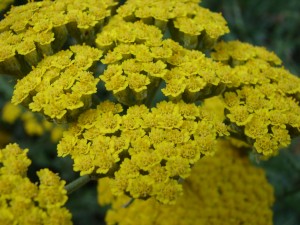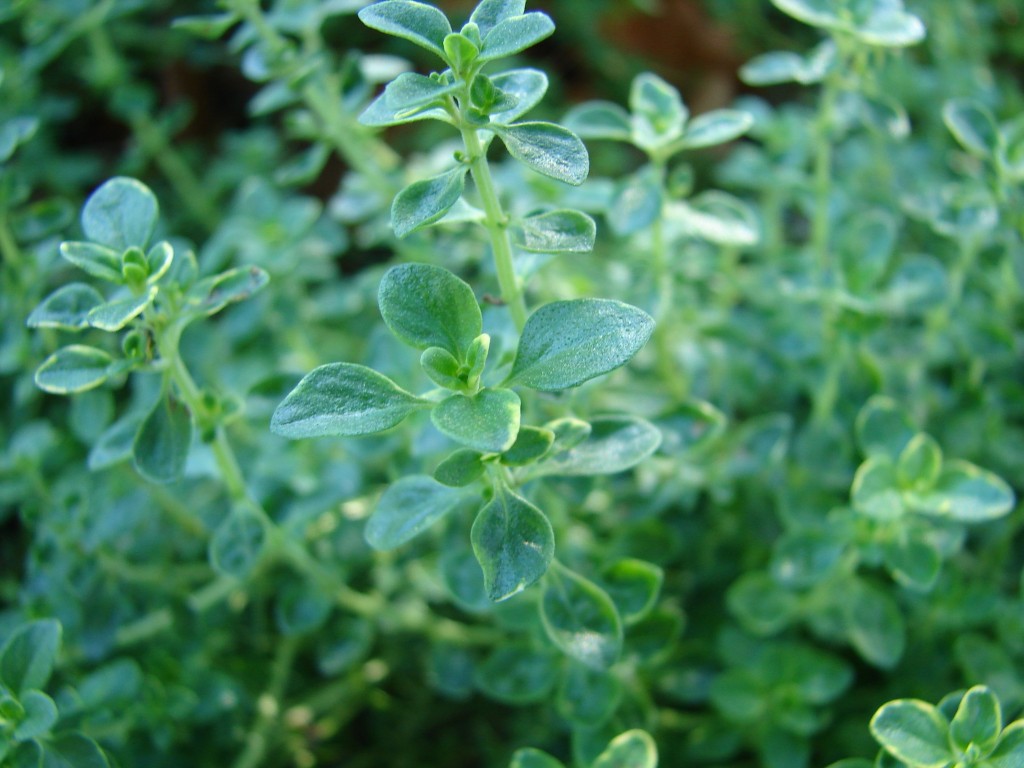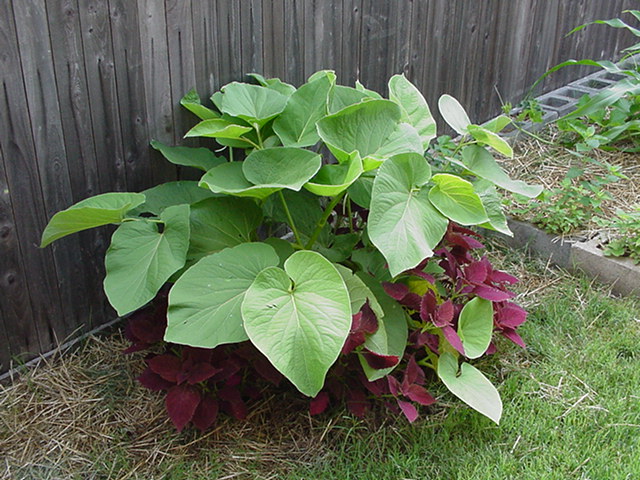Jun
05

Santolina
Santolina (Santolina chamaecyparissus) is also called Lavender Cotton and is originally from Europe. It is actually an herb that is evergreen in my garden but would be perennial further north. It’s hard to tell in this picture, but the foliage is actually a silver/grey and the flower and foliage both hold up will for cutting.
The leaves have a wonderful, almost lavender, smell when brushed or crushed. I love the smell, but evidently moths don’t. One of the herbal uses for Santolina is as a moth repellant.
This is a very drought tollerent plant. About the only problem you might have with it is if the soil doesn’t drain well enough. It loves the extremely hot dry weather and full sun and will bloom all summer long. I like to deadhead it a bit when it starts looking too leggy.
-- Weather When Posted --
- Temperature: 77°F;
- Humidity: 48%;
- Heat Index: 79°F;
- Wind Chill: 77°F;
- Pressure: 29.92 in.;
May
27

Lemon Thyme
Thyme is incredible stuff! So is time, but thyme it one of my favorite seasonings for eggs and it is especially good fresh. I have grown creaping thyme, lemon thyme, wooly thyme and regular common thyme. My favorite by far is the lemon thyme. That is also the one that has done the best in my garden. It has stood up to people, dogs, cats and chickens; winters and summers; flood and drought.
Thyme has a long history. It was thought to be a cure for “melancholy” by the Romans and it was a symbol of courage for the Greeks. The ancient Egyptians used it for embalming. It’s origin is probably Greece (and other Mediterannean areas?) since the name is from the Greek word thymos meaning “smoke” or “spirit.
There are about 350 species of thyme and a lot more hybrids and cultivars. I has also been used medicinally as an antiseptic, antibacterial and antifungal herb. Thyme leaves hold their flavor very well when dried, but I still like it best fresh and, since it is an evergreen in Texas, I don’t have to settle for anything else. The highly aromatic leaves and flowers are used in all kinds of food and teas. Thyme has been used in ethnic cuisine all over the world.
The plant is a very drought tollerant plant for full sun. It has tiny star shaped flowers (red, pink or white) through the summer. Mine just finished a spring bloom and are gearing up for a more steady bloom over the summer. There are upright versions, like this one, and there are creeping versions which are great between pavers. They release a wonderful fragrance any time some one steps on them. I need to get more of the creeping varities to plant between the pavers in my new path! If it gets enough sun there…
Oh… and the bees love it!
-- Weather When Posted --
- Temperature: 79°F;
- Humidity: 43%;
- Heat Index: 79°F;
- Wind Chill: 79°F;
- Pressure: 29.85 in.;
May
26

St. John's Wort
St. John’s Wort (Hypericum) is famous for it’s pharmaceutical properties and it’s uses as an herbal treatment for depression. There are over 300 species of Hypericum and I have no clue which one this is. I think it’s a gorgeous plant, though. It makes a mounding evergreen shrub about 3 feet tall and it will be loaded with pretty yellow flowers all summer long and the leaves will turn sort of red in the fall and winter. Even though it is an evergreen in my yard, it is considered a perennial herb.
St. John’s Wort is very easy to grow and I have had great success in starting cuttings from it. Mine gets part shade, but it can take full sun also.
St. John’s Wort was originally from Europe and it is considered a toxic and noxious weed in some areas. It is not, however,

St. John's Wort
listed as an invasive species for Texas and, in fact there are even three species of Hypericum that are listed as being native to Texas. Mine does not appear to be one of the native ones – it appears to be Hypericum patulum henryi or “Golden Cup” St. John’s Wort.
-- Weather When Posted --
- Temperature: 95°F;
- Humidity: 31%;
- Heat Index: 95°F;
- Wind Chill: 95°F;
- Pressure: 29.65 in.;
May
21

Hoja Santa and Coleus
This is the Hoja Santa (Piper auritum), from Central America. It is commonly known as the “Root Beer Plant” because it tastes and smells, well, like root beer. This one is pictured at the beginning of the growing season and will get much larger by the end of summer – to about 4 or 5 feet tall and the leaves can be as big as 10 to 12 inches across.
Hoja Santa has soft, fuzzy heart shaped leaves. If flowers during the summer, but the flowers are a very odd long white spike (no petals). It is very easy to grow. Maybe too easy so make sure you like it. It will spread by underground stolons. It is damaged by high winds and can be killed by a hard freeze but, so far at least, it has acted like a perennial in my garden.
Hoja Santa is considered an herb is been used in Guatamalan and Mexican cooking to flavor soups and eggs, fish or meat (wraped in a leaf), and chocolate drinks. Even so, there is some confusion over whether it is safe to eat. This is from Wikipedia:
The essential oils in the leaf are rich in safrole, a substance also found in sassafras, which has been shown to be carcinogenic in animals. In 1960, the U.S. Food and Drug Administration banned sassafras bark along with sassafras oil and safrole as flavoring agents because of their carcinogenic properties[14] and the Council of Europe imposed the same ban in 1974,[17] although toxicological studies show that humans do not process safrole into its carcinogenic metabolite.[18]
Moderation would probably be the best policy if you plan to use it for cooking. I would grow mine anyway just because I like the look (and touch and smell).
The same Wikipedia article says that the reason it is called “Hoja Santa” is because legend says that the Virgin Mary dried the diapers of baby Jesus on the leaves. Oooh gross!
-- Weather When Posted --
- Temperature: 86°F;
- Humidity: 32%;
- Heat Index: 86°F;
- Wind Chill: 86°F;
- Pressure: 29.97 in.;
May
15

Lamb's Ear
Lamb’s Ear is such a cool herb! The scientific name is Stachys byzantina and it is native to Turkey, Armenia and Iran. The silvery evergreen leaves are soft and furry and almost feel like velvet. It’s grown more for the texture of the leaves, but it does also produce tiny purple flowers on tall stalks that the bees absolutely adore.
Lamb’s ear is another very drought tolerant plant and needs well drained soil. It develops crown rot if it stays too wet.
One word of warning… it will spread. A lot. The seedlings are easy to identify for weeding, but there will be a lot of them. You can hold down the spreading a little bit by cutting of the flower stalks. I have seen lamb’s ear listed as an invasive species, and I’m sure it is somewhere, but it is not on the Texas Invasive Species database. You might, however, check with your local county extension office before planting it.
This is not one I would pay for at the nursery. It is just to easy to get one from someone that is already growing it.
Lamb’s ear is a medicinal herb rather than a culinary herb. It also goes by the name “Woundwort” because it was once used as a styptic and to bandage wounds. It may also have antiseptic properties. It is also supposedly a great companion herb that helps other plants grow better.
-- Weather When Posted --
- Temperature: 87°F;
- Humidity: 47%;
- Heat Index: 88°F;
- Wind Chill: 87°F;
- Pressure: 29.87 in.;
May
06

Elderberry Blossoms

Elderberry Bush
Who knew that the elderberry was such a pretty plant? The bush is about 12 feet tall and has gorgeous blossoms on it. It is actually considered to be an herb with numerous superstitions surrounding it.
In the Middle Ages, legend says that the tree was home to witches, and that cutting down one would bring on the wrath of those living in the branches.
The Russians and the English believe that the trees ward off evil spirits and it was considered good luck to plant a tree near your home. Sicilians think that sticks of the wood can kill serpents and drive away thieves.
Egyptians discovered that applying its flowers improved the complexion and healed burns. Many early Indian tribes used it in teas and other beverages. The British frequently drank home made wine and cordials that was thought to prolong life and cure the common cold. – The Herbal Information Center
Our elderberry has just started blooming for this season. In the fall, it will have tiny black berries where each little flower had been.
The reason we planted ours was not for the beauty or the berries. Supposedly, elderberries produce a lot of humus in the soil and the area we planted it in needed all the help it could get. It was hard packed clay there and would flood every spring.
The elderberry is also great for attracting all sorts of wildlife. We have seen lots lizards and birds call it home.
I have never been able to figure out how to use the berries. I need to make it a mission to find a good recipe for elderberries this year and give it a try. But if we don’t eat them, the birds certainly will!
Apr
21

Basil
I love it! I love the taste. I love the smell. I love the shape of the plant. And basil must like me too because my plants tend to get huge. But that’s OK. I will eat it all summer long!
There are many different varieties of basil and I have tried several, but my favorite is still the plain old ‘Sweet Basil’ or the ‘Genovese Basil’. It reminds me of the three years I lived in Italy.
Although it’s not a native to Texas, basil is so easy to grow here and a must for any herb garden. it is incredible in any pasta dish. It will grow strong up until the first frost with a slight lag during the highest heat of the summer (this may be more of a water issue since I tend not to do a lot of extra watering).
Basil will start to flower later in the season. At this point, I usually cut it back pretty good from the top and use the youngest leaves and toss the rest in the compost. The older leaves start to get a strong hot flavor to them.
For a great summer salad, try slicing up some homegrown tomatoes along with some fresh mozzarella (you know, the wet kind) and then top with basil cut into small strips. Don’t wash the basil too much or you will lose a lot of the flavor – just enough to knock and dirt or sand off of it. Then drizzle some olive oil over it and give it a good sprinkling of sea salt. This is what is called a ‘Caprese Salad’. You can eat it like this or put it on a nice crusty roll and eat it like a sandwich. Yum!










